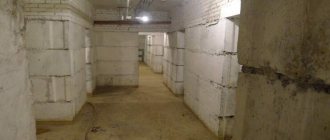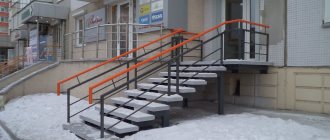Construction Materials
Construction Materials
Reading time: 4 minutes
AA
29942
We will send the material to you:
As a rule, residents of a multi-storey building are interested in the question of the ownership of the basements in their houses, and are especially interested in the question of whether it is possible to make storage rooms in the basement of an apartment building.
Many property owners in apartment buildings argue that the acquisition of an apartment in a residential building is accompanied by the allocation of space to the new owners from the common property.
Loading …
If you study regulations, amendments, clarifications, restrictions and other legislative documents, it becomes obvious that legally the basements of residential buildings of an apartment building are common property, therefore all homeowners have equal access to such premises.
It is worth understanding how things work in practice, especially since such premises are often used for other purposes, such as a storage room, for example. Particularly practical owners seek to benefit from such additional useful space, arranging them at their own discretion.
Basement
It is necessary to understand the peculiarities of using the underground premises of apartment buildings. What are they intended for, what communications are located there, what types of equipment are installed there, and who may have access.
Particular attention should be paid to those cases when apartment owners in a building arbitrarily arrange basements in accordance with their needs, as well as problems that an apartment owner may encounter when arranging personal space in a common area.
How are basements used in apartment buildings?
In apartment buildings, the basement, as a rule, performs a technical function - all communications, equipment and systems responsible for the life support of the house are located there.
List of systems and communications with access to underground premises:
- Supply of cold and hot water;
- Sewage outlets and drainage of water for technical purposes;
- Electricity of the net;
- Steam heating;
- Main distribution board throughout the entrance;
- Boiler room with equipment;
- Household meters;
- The base of the elevator shaft.
Access of unauthorized persons to the basement and their interference in the functioning of various systems is prohibited. This may affect the operation of certain communications, which may lead to a risk to the lives of all residents.
For this reason, basement windows are usually covered with metal bars and doors have iron locks. As a rule, access to the basement is given to the person in charge of the house, elected at meetings of residents, as well as to utility workers.
Storage rooms in a residential building
Chairman of the Veta HOA
The procedure for the allocation and use of storage rooms
1. General Provisions:
1.1. Owners of residential and non-residential premises in an apartment building have the right to allocate space to equip a storage room in the basement of the apartment building (subject to availability).
1.2.
The owner of a residential or non-residential premises in an apartment building at the address: , (hereinafter referred to as the owner of the storage room), upon a written application, the board is allocated a premises or part of it in the basement of the house without acquiring ownership of the specified premises, without the right to transfer it to a third party. The premises or part thereof are allocated, if there are free spaces, from among the premises recognized by the inventory commission of the HOA board as suitable for equipping a storage room.
1.3. A place is allocated upon a written application from the user addressed to the chairman of the Veta HOA.
1.4. The owner of the storage room is obliged to provide keys to the chairman of the board of the Veta HOA for unhindered access to the storage room in case of emergency.
1.5. The owner of the storage room is obliged to provide access to the storage room to monitor compliance with the rules for the use of basement premises at the request of members of the board of the Veta HOA.
1.6. The owner of the storage room is obliged to comply with fire safety requirements.
1.7. The owner of a storage room is obliged to comply with sanitary and epidemiological requirements for the operating conditions of non-residential premises.
1.8. The owner of the storage room has the right to install electrical networks into the premises only after coordinating the work with the chairman of the board of the Veta HOA with the obligatory equipment of the networks with metering devices and residual current devices (RCDs).
1.9. The owner of the storage room is obliged to take measures aimed at preventing the occurrence and spread of infectious diseases associated with the sanitary condition of the basement, including the destruction of insects and rodents.
1.10. When equipping a storage room with doors, it is necessary to provide for the presence of ways for natural ventilation of the premises (arrangement of vents, transoms, openings in the doors)
1.11.
Owners of storage rooms take part in repairing entrance doors to the basement and replacing locks, making duplicate keys, as well as in repairing and putting things in order in basements by decision of the board of the Veta HOA or at the request of the HOA chairman.
Associated use of a basement in an apartment building
Sometimes a part of the basement where communications are not installed can be used by the management company to arrange utility or technical premises.
- For example, a house management company can equip its technical areas or repair shops in these places;
- The Ministry of Emergency Situations in the city can make a bomb shelter or warehouse to house protective equipment in case of danger;
- In the basements of houses with a ground floor, various government agencies, archives or interest groups can be located.
But such phenomena are infrequent, especially bomb shelters. This also applies to the old stock of secondary housing; at the moment, if public utilities occupy the basement, then only an insignificant part of it.
It is necessary to take into account the fact that modern houses have basements equipped for use for economic purposes. To do this, the design includes storage rooms in the basement of an apartment building in places where there are no communications.
Options for using plinths by apartment owners
The high price per square meter of real estate leads to the fact that owners try to make the most of every square meter provided to them. Accepting the equivalence of underground ownership, residents try to adapt part of it for personal needs.
Many owners would like to use the basement for various purposes:
- A home workshop, which is used not only for repairing and repairing household items, but also works to order, for example, repairing shoes, small household appliances, etc.;
- Pantry for preserving food for the winter, both prepared ingredients and fresh vegetables. If the basement is equipped with ventilation systems, it is dry and there is protection from unauthorized persons - this is a very beneficial solution for the population in the city;
- Storage room for currently unnecessary furniture, items that are not currently in use, sports equipment, skis, bicycles, etc.
- Owners living on the first floors of the house can redesign part of the room by filling the floor and insulating the walls. This requires approval and permission from the BTI. After such work, the entrance to the underground is cut out in the apartment and additional space is equipped at your discretion.
Sale
There is a possibility of purchasing a utility room as a property. Under what conditions is such an operation possible, since the entire area of the house is the property of the apartment residents?
- If the storage room was purchased with an apartment on the principle of co-investment, then the owner can sell it at his own discretion. In this case, the consent of other residents of the apartment building is not required.
- First of all, it is necessary to distinguish the concepts of storage rooms from the common property of apartment building residents. What is the common property of the house? According to the law, it includes those premises that are not part of the apartment and are used to service more than one room in the building.
Such property includes stairs, attics, elevators, and basements. But pantries are not included in this concept. This rule applies to houses sold under an equity participation agreement.
Residential premises are sold according to the DDU, and non-residential premises are also sold according to it. An apartment can be purchased together with non-residential premises under a co-investment agreement, as a result of which the sale of such property is possible.
What standards are there for storage rooms in the basement?
Residential multi-apartment buildings must operate in accordance with the Fire Regulations, which are valid throughout the Russian Federation. According to Article 38 of the Federal Law “On Fire Safety” (No. 69), all owners of property and its users bear responsibility for any violations of these Rules.
In most cases, the management of a residential building is entrusted to the management company or HOA; in this case, the responsibility for complying with fire safety rules and ensuring the safety of all residents falls under the responsibility of the employees of this organization. Employees of the HOA or management company that maintain the building must, during the spring inspection, at least once a year, inform all owners and tenants about the rules for operating equipment and housing.
With regard to basements and storage facilities installed in them, the legislation of the Russian Federation explains that the arrangement of workshops or other premises for utility purposes in the basement or basement without arranging a separate exit in them is strictly prohibited.
The same applies to exits to storage rooms in the basements of residential buildings, which are not equipped with fire barriers on the way from public stairwells. The law also prohibits the use of technical premises for the purpose of equipping storage areas for furniture, equipment, workshops, food and other things.
Before organizing storage rooms in the basement of an apartment building, fire safety standards are studied most carefully so that structures with violations do not have to be dismantled.
How is the area distributed?
For some time, high-rise buildings with wheelchairs on the ground floor were built. What is a stroller? This is a separate room for storing baby strollers belonging to the residents of the house.
But the utility room is used for this purpose in rare cases. More often, the inventory of technical workers servicing the house is stored there. This room can be used for the work of HOA employees, because you need to store documents, equipment, and other things somewhere.
The storage rooms in the house belong to all apartment owners; how to use them is decided by the general team. The area near such premises should not be littered, cluttered with building materials or old belongings of apartment owners - passages to emergency exits and garbage chutes should be clear.
ATTENTION! You should not arrange the storage room at your own discretion and use it for your own purposes.
In this case, the meeting of owners has every right to decide to vacate the technical premises, and even through the court it will not be possible to defend the storage room.
The legal side of the issue of tenants' ownership of the basement
Indeed, the basement of an apartment building belongs to everyone, but at the same time, to no one. Therefore, before starting any work, it is necessary to legally reserve the right to use part of such premises. Privatization of basement premises is carried out in the following order:
General meeting of residents
A general meeting of residents of the house is held in accordance with the requirements of the housing code. The agenda includes the alienation of part of the property in favor of apartment owners and changing the boundaries of the premises . Residents of the building are notified 10 days before the meeting, and the turnout must be at least 50% of the number of apartments in the entire building.
At least 50% of all those present must also vote in favor of the issue under discussion. If the building is a dormitory, then it is necessary to enlist the support of the owner.
Redevelopment project
They are approved by various institutions (fire departments, sanitary and epidemiological institutions) and sent for approval to the BTI. At the project creation stage, it is necessary to take into account the existing communications and equipment, the purpose of the basement after redevelopment and compliance with fire safety rules, since people’s lives are at stake.
The main requirement is the possibility of access to the premises at any time of the day for workers of utility services or a management company, if there is a need for sanitation or work with heating or water supply pipes.
If there will be people in the basement after the redevelopment, it is necessary to install electricity, provide heating and supply and exhaust ventilation.
Reconstruction
After receiving approval from the BTI, reconstruction is carried out. It must be accepted in finished form by an expert commission, after which an application for issuing a technical passport of the premises . For owners, such a solution will at least also be beneficial in terms of utility payments - the size of common property becomes smaller, and the number of payers will increase.
Obtaining a certificate from Rosreestr
The final document for registering property is the conclusion of Rosreestr on state registration of rights. The application is accompanied by the consent of the owners of the apartments in the building in the form of minutes of the meeting, a technical passport from the BTI, and a receipt for payment of the state duty.
It will not be possible to completely privatize the basement premises in any case - you can register the right only to that part where there are no communications and no influence on the utility networks of the house.
Category of storage rooms in the basement of a residential building
D 2.
11 In medical institutions: a) staff premises (rooms for training staff, visiting teams); b) premises for auxiliary services, thermostatic room, room for preparing media, central linen rooms, rooms for preparing working disinfection solutions, washing rooms, including for patients, central sterilization, disinfection departments, rooms for storing and dressing corpses, mourning hall, rooms for processing medical waste, sanitary checkpoints, sanitary rooms, storage rooms for patients' belongings, equipment repair rooms, pharmacies; c) procedural radiation therapy and radiation diagnostics (X-ray, magnetic resonance), control rooms with them and other rooms that form a single functional process with them; d) premises and rooms for rehabilitation treatment (physical therapy rooms, therapeutic pools, hydrotherapy rooms, massage rooms).
Is it possible to make storage rooms in the basement of an apartment building?
D.2.7 Unloading, loading, unpacking; expedition for various institutions, organizations; storage, unloading and sorting rooms for luggage, storerooms and storage facilities of all types. Premises for collecting and packaging waste paper. D 2.
8 Technical and engineering rooms (heating points, pumping rooms, compressor rooms, ventilation chambers, distillation rooms, building maintenance workshops, server rooms). Additionally by building type D.2.
9 In the buildings of preschool organizations: a vegetable pantry, a pantry for gardening tools, pantries. D 2.
10 In the buildings of educational institutions: laboratories and classrooms for the study of special subjects with special equipment; labor and safety rooms; workshops not prohibited by sanitary and fire safety standards.
Storage rooms in the basement of a residential building
As a rule, residents of a multi-storey building are interested in the question of the ownership of the basements in their houses, and are especially interested in the question of whether it is possible to make storage rooms in the basement of an apartment building. articles
- Basement
- Purpose of basements
- Associated use of a basement in an apartment building
- Options for using the basement by apartment owners
- The legal side of the issue of tenants' ownership of the basement
- Features of basements
- conclusions
Many property owners in apartment buildings argue that the acquisition of an apartment in a residential building is accompanied by the allocation of space to the new owners from the common property.
You have javascript disabled
If you study regulations, amendments, clarifications, restrictions and other legislative documents, it becomes obvious that legally the basements of residential buildings of an apartment building are common property, therefore all homeowners have equal access to such premises. It is worth understanding how things work in practice, especially since such premises are often used for other purposes, such as a storage room, for example. Attention Particularly practical owners seek to benefit from such additional useful space, arranging them at their own discretion. Basement It is necessary to understand the peculiarities of using the underground premises of apartment buildings. What are they intended for, what communications are located there, what types of equipment are installed there, and who may have access.
Storage rooms in the basement of an apartment building
The main requirement is the possibility of access to the premises at any time of the day for workers of utility services or a management company, if there is a need for sanitation or work with heating or water supply pipes. If there will be people in the basement after the redevelopment, it is necessary to install electricity, provide heating and supply and exhaust ventilation.
- After receiving approval from the BTI, reconstruction is carried out.
It must be accepted in finished form by an expert commission, after which an application for issuing a technical passport of the premises is sent to the BTI.
For owners, such a solution will at least also be beneficial in terms of utility payments - the size of common property becomes smaller, and the number of payers will increase.
Storage room in the basement
MKD, an advantage over other owners in obtaining a basement specifically for your apartment? read answers (3) Topic: Basement Interested in a question about the basement.
Our house is an apartment building. All residential apartments are on social rent.
Is it possible to arrange storage rooms in the basement? When selling an apartment in a housing cooperative, is the storage room in the basement automatically sold? Or, after the sale of the apartment, it can be sold separately. read the answers (2) Topic: Common property of the owners. I am interested in whether the REP management company can order the storage room in the basement of a residential building to be cleared. read the answers (2) Our question seems to be petty, but the problem is serious.
- Supply of cold and hot water;
- Sewage outlets and drainage of water for technical purposes;
- Electricity of the net;
- Steam heating;
- Main distribution board throughout the entrance;
- Boiler room with equipment;
- Household meters;
- The base of the elevator shaft.
What is special about basements?
The basement premises of an apartment building are very convenient for use by residents. Their location and low cost attract commercial organizations for the arrangement of various retail and industrial premises. It is important to remember the specifics of underground premises:
- Constantly high level of humidity;
- Underground location below the soil surface;
- Lack of sufficient natural light;
- If groundwater is close to the surface, periodic flooding is possible;
- Forced ventilation is required, usually a supply and exhaust circuit.
conclusions
To summarize, we can say that if you want to use the basement of an apartment building, you need to come to an agreement with all the residents and jointly arrange the underground premises for utility purposes. When properly equipped, storage rooms in the basement of an apartment building can significantly improve the living comfort of apartment building owners.
For commercial use for profit, it is worth transferring the technical premises to non-residential premises and drawing up all the necessary documents for private property rights.
YouTube responded with an error: The request cannot be completed because you have exceeded your quota.
Floor and ceiling repair
Rolled waterproofing is laid in the basement on a gravel cushion, and the waterproofing must be done efficiently and accurately, forming a continuous coating. If the room is supposed to be used for storing food and it must be cool, then a concrete screed is poured.
Floor repairs must be carried out carefully
Read more: basement floor waterproofing technologies.
If waterproofing is carried out using coating materials, they are applied to the concrete base, and the finished floor screed is laid on top. You can lay linoleum on top of the concrete in the basement; it is quite practical and easy to clean. If desired, the floor in the basement can be made of wood, tile or self-leveling.
A basement ceiling is usually the floor slab of the first floor of a home. When using the basement to store food, the ceiling does not require additional finishing.
In other cases, it is insulated. The ceiling is insulated by gluing polystyrene foam boards onto it. In case of significant differences in height, it is better to use mineral wool for insulation. It is placed inside a pre-assembled wooden or aluminum frame, which is then covered with plywood, gypsum fiber boards or fiberglass board. After this, the ceiling is finished.
It should be remembered that if additional living space is planned in the basement, heating and ventilation must be installed. Often in this case, heated floors are installed in the basement.







